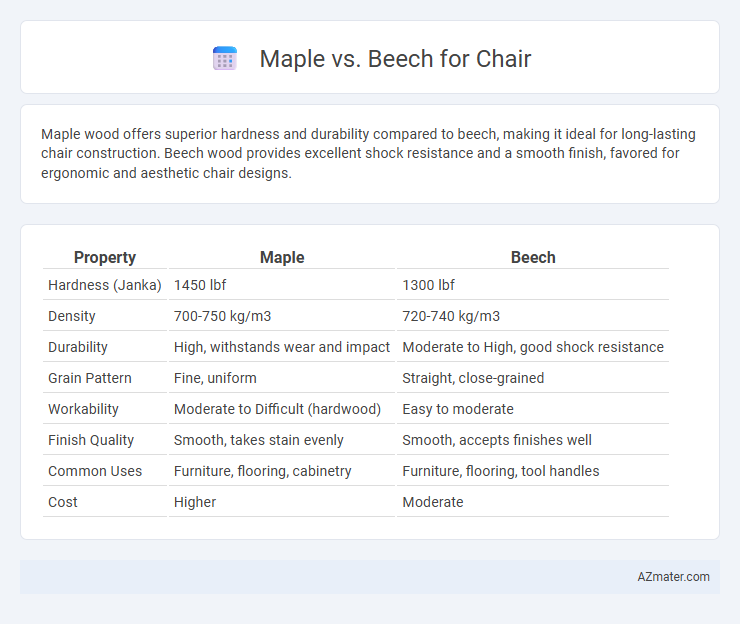Maple wood offers superior hardness and durability compared to beech, making it ideal for long-lasting chair construction. Beech wood provides excellent shock resistance and a smooth finish, favored for ergonomic and aesthetic chair designs.
Table of Comparison
| Property | Maple | Beech |
|---|---|---|
| Hardness (Janka) | 1450 lbf | 1300 lbf |
| Density | 700-750 kg/m3 | 720-740 kg/m3 |
| Durability | High, withstands wear and impact | Moderate to High, good shock resistance |
| Grain Pattern | Fine, uniform | Straight, close-grained |
| Workability | Moderate to Difficult (hardwood) | Easy to moderate |
| Finish Quality | Smooth, takes stain evenly | Smooth, accepts finishes well |
| Common Uses | Furniture, flooring, cabinetry | Furniture, flooring, tool handles |
| Cost | Higher | Moderate |
Overview: Maple vs Beech for Chairs
Maple and beech are two popular hardwoods commonly used in chair manufacturing, each offering distinct qualities. Maple is prized for its durability, fine grain, and light color, making it ideal for polished, smooth chair surfaces that withstand heavy use. Beech, known for its strength and flexibility, provides a slightly reddish hue and excellent shock resistance, making it suitable for ergonomic and curved chair designs.
Wood Characteristics: Maple and Beech
Maple wood offers exceptional hardness and durability, making it ideal for chair construction where strength and resilience against wear are essential. Beech wood features a fine, tight grain with moderate hardness, providing a smooth finish and excellent shock resistance suitable for comfortable seating. Both woods exhibit excellent workability and resistance to abrasion, but maple tends to have a lighter coloration while beech shows a warm, reddish hue that enhances aesthetic appeal.
Durability and Strength Comparison
Maple wood offers exceptional durability and strength, making it a preferred choice for chair construction due to its resistance to wear and dents. Beech wood also provides good strength and durability but is generally softer and more prone to surface damage compared to maple. Chairs made from maple tend to have a longer lifespan and better support heavier loads, enhancing their overall structural integrity.
Workability and Machinability
Maple offers excellent workability with its dense, yet fine-grained texture, allowing precise cuts and smooth finishes ideal for chair-making. Beech wood is highly machinable, featuring a straight grain and uniform texture that enables easy shaping and sanding with minimal tool wear. Both woods balance strength and ease of handling, but maple's superior hardness provides greater durability for long-lasting chairs.
Aesthetic Differences: Grain and Color
Maple chairs exhibit a smooth, fine grain pattern with a pale creamy color that offers a clean and contemporary aesthetic. Beech chairs feature a tighter, slightly more pronounced grain with a warm, reddish-brown hue, lending a cozy and traditional look. The choice between maple and beech impacts the chair's visual appeal, with maple providing brightness and beech delivering warmth and depth.
Comfort and Ergonomics in Chair Design
Maple wood offers a dense, sturdy frame that enhances the ergonomic support of chairs, providing stability and durability essential for comfort during prolonged use. Beech wood features a slightly softer texture, allowing for subtle flex and contouring, which can improve seating comfort by reducing pressure points. Both hardwoods support ergonomic designs, but maple's rigidity favors structural integrity while beech's natural flexibility aids wearability and user comfort.
Finishing and Staining: Maple vs Beech
Maple offers a smooth, closed grain that accepts stains evenly, resulting in a consistent, polished finish ideal for elegant chair designs. Beech features a slightly open grain that can absorb stain unevenly, often requiring pre-treatment or sealers to achieve a uniform color. Both woods finish well, but maple's fine grain ensures a more predictable staining process, making it preferable for high-quality, refined chair finishes.
Cost and Availability Analysis
Maple wood tends to be more expensive than beech due to its durability and fine grain, making it a premium choice for high-quality chairs. Beech offers greater availability and affordability, widely used in mass production because of its uniform texture and ease of workability. Cost-effective and readily sourced from European and North American regions, beech chairs provide budget-friendly options without sacrificing moderate strength.
Environmental Impact and Sustainability
Maple wood offers a durable and long-lasting option for chairs, harvested primarily from sustainable North American forests with efficient growth cycles that support carbon sequestration. Beech wood, sourced mainly from European forests, is also renewable but sometimes linked to higher environmental costs due to slower growth rates and less sustainable logging practices. Choosing maple over beech can reduce environmental impact by promoting faster forest regeneration and lower carbon footprints associated with furniture production.
Best Uses: Choosing Maple or Beech for Chairs
Maple offers exceptional durability and fine grain, making it ideal for high-traffic chairs that require strength and a smooth finish, such as dining or office chairs. Beech provides a slightly softer texture with excellent shock resistance, perfect for chairs that need comfort and a warm appearance, like kitchen or casual seating. Both woods finish well, but maple suits heavy use environments, while beech excels in creating lightweight, comfortable furniture.

Infographic: Maple vs Beech for Chair
 azmater.com
azmater.com